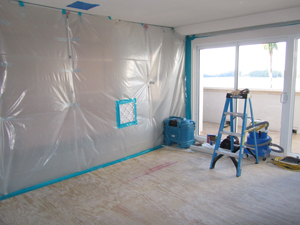Thorough Mold And Mildew Remediation Solutions for Total Indoor Air Quality Reconstruction
Mold and mildew invasions in interior rooms can position considerable threats to both residential or commercial property and human wellness. By exploring in-depth mold remediation options that incorporate detailed assessment, strategic removal techniques, and positive prevention steps, one can genuinely recover interior air top quality to its optimal state.
Understanding Mold and Its Dangers
Mold, a type of fungus that flourishes in damp environments, positions significant health risks to individuals exposed to it. Mold and mildew spores can quickly end up being airborne and be inhaled, resulting in a variety of health concerns. Usual signs and symptoms of mold and mildew exposure consist of respiratory system troubles, allergies, skin inflammation, and much more extreme reactions in individuals with compromised body immune systems. Extended exposure to mold can exacerbate status quo such as asthma and allergies, making it crucial to resolve any kind of mold infestations without delay.
Mold growth can deteriorate floors, ceilings, and walls, jeopardizing the stability of the framework over time. Recognizing the threats associated with mold is vital for carrying out effective remediation techniques to make sure the health and wellness and safety and security of owners and the long life of the structure.
Correct Analysis and Inspection Techniques
Effective assessment and inspection techniques are essential in accurately identifying and evaluating the extent of mold and mildew problems within a framework. Mold and mildew evaluation usually begins with a thorough aesthetic examination performed by skilled experts - mold removal philadelphia. This aesthetic evaluation aims to recognize locations of mold growth, water damages, and dampness invasion that might be adding to the mold problem. In enhancement to visual evaluations, various tools such as dampness meters, thermal imaging cams, and air sampling tools may be utilized to analyze the degree of mold contamination and to recognize covert mold and mildew resources within floors, wall surfaces, or ceilings.
Furthermore, appropriate analysis strategies involve figuring out the kind of mold present, as different mold and mildew varieties might require particular removal approaches. Sampling techniques, including air tasting and surface area tasting, can aid in identifying the types and concentration levels of mold and mildew spores existing in the interior setting. By using comprehensive evaluation and assessment methods, removal specialists can create targeted and reliable strategies to eradicate mold infestations and restore indoor air quality to risk-free levels.
Efficient Mold Removal Techniques
Executing tested remediation techniques is important for successful removal of mold from indoor environments. When dealing with mold and mildew elimination, it is important to begin by attending to the resource of wetness to avoid visit the site future growth. Containment of the damaged location is crucial to avoid the spread of mold spores to uncontaminated locations. This can be attained with making use of physical obstacles like plastic sheeting and adverse air stress systems.

It is crucial to deal with any kind of underlying issues triggering dampness buildup to stop future mold and mildew problems. By complying with these approaches vigilantly, total mold and mildew eradication can be accomplished, recovering interior air quality successfully.
Protecting Against Future Mold Growth
Dealing with the root creates of dampness build-up is paramount in stopping future mold and mildew growth within interior environments. To effectively prevent mold from returning, it is crucial to regulate humidity levels below 60%, as mold and mildew thrives in damp conditions. By a fantastic read resolving these factors and carrying out positive steps, people can successfully decrease the threat of future mold development and preserve a healthy indoor environment.
Making Certain Long-Term Indoor Air High Quality
Preserving optimum interior air quality over the lengthy term needs a comprehensive strategy that includes normal monitoring and aggressive steps. Regular air high quality assessments via specialist testing can aid recognize any kind of arising problems without delay. Implementing a robust air flow system that ensures correct air movement and adequate purification is crucial for maintaining clean indoor air. Regular HVAC maintenance, consisting of filter substitutes and air duct cleansing, is vital in stopping the build-up of pollutants that might jeopardize air quality.
Along with tracking and maintenance, advertising good interior air high quality practices amongst passengers is important for long-term performance. Motivating habits such as appropriate ventilation, decreasing sources of interior contamination, and decreasing dampness levels can significantly add to a healthier interior environment. Education and learning and awareness projects about the relevance of indoor air high quality can aid promote a society of obligation and mindfulness amongst employees or citizens.
Conclusion
Finally, comprehensive mold and mildew removal services are essential for total interior air top quality remediation. Recognizing the threats of mold, carrying out proper evaluation and inspection methods, implementing efficient elimination strategies, avoiding future mold and mildew development, and guaranteeing long-lasting interior air top quality are all essential action in keeping a healthy indoor environment. By complying with these actions faithfully, individuals can create a tidy and secure living room free from the damaging impacts of mold and mildew contamination.

In addition, appropriate analysis techniques include establishing the type of mold and mildew existing, as different mold varieties may need details remediation techniques.The following action in effective mold elimination is the physical elimination of mold nests. To successfully protect against mold from returning, it is vital to regulate humidity levels below 60%, as mold and mildew grows in damp conditions. Comprehending the risks of mold and mildew, performing proper assessment and assessment strategies, applying effective removal techniques, stopping future mold and mildew development, and making certain lasting interior air quality are all essential steps in preserving a healthy indoor atmosphere.